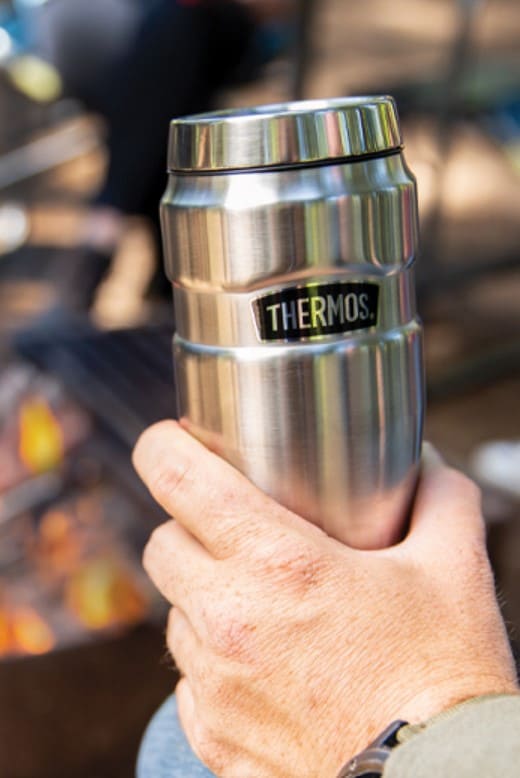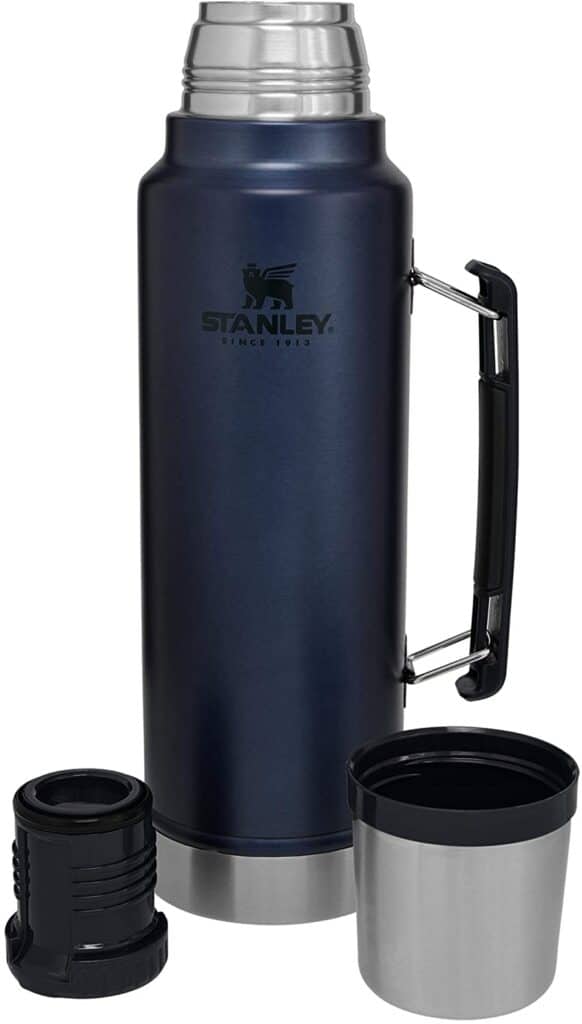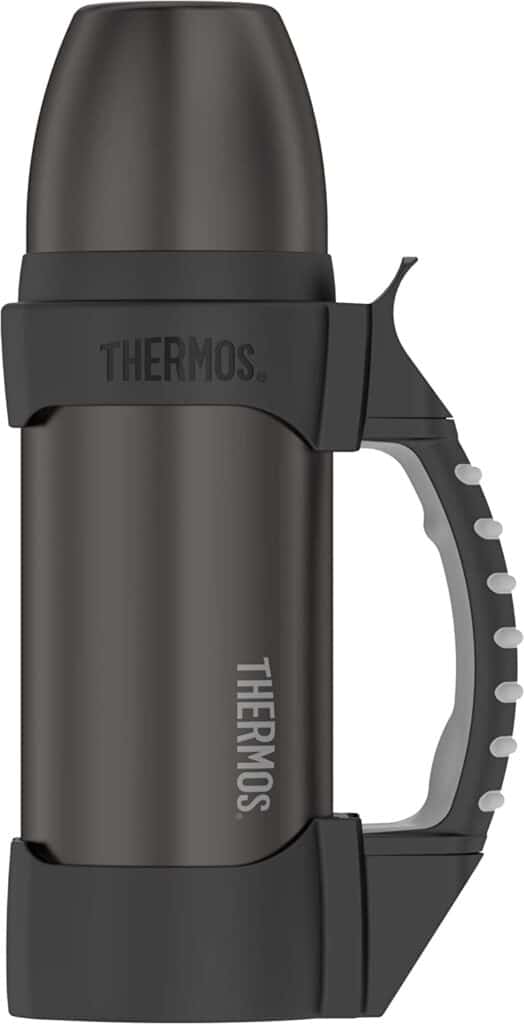Brewing anything less than a full pot of coffee in the morning is way too risky for my taste. I’d rather deal with a little extra rather than becoming depleted on my…groggier of mornings.
But in doing that, I usually find myself with some extra brew before leaving for work. I’m not saying that I’m too good for day-old coffee, but the stuff isn’t cheap, and I want the best bang for my buck.
Buying a good thermos was a game-changer. Besides not wasting unused coffee, I didn’t have to deal with the hassle of stopping on my way to work. Which saves me from “I’m late calls” to my boss.
On average, coffee will last about 24 hours inside a thermos. But for those aficionados that get serious about this stuff, you might want to use a thermometer. If your coffee temps at 140*F (60C) 5 hours after brewing, your coffee should be sufficient for another 8-9 hours.
If you’re looking for two quick thermos recommendations check out Stanley Classic Vacuum Insulated Wide and the Thermos Work Series Stainless Coffee.
Outside Temperature Matters

Given that, there are many contributing factors that may shorten or prolong that duration.
What’s the room temp at? Even though thermos has insulative properties, outside conditions can affect your coffee’s warmth (or cold). My thermos tends to keep my coffee warmer in my apartment than it does at my job.
But this can depend on the integrity of the thermos. Is it airtight? Because if not, your coffee will immediately begin to degrade when exposed to the open air, giving it a very bitter taste.
This is called oxidation. Coffee has an unusually high PH balance, meaning it’s very acidic.
This isn’t usually an issue, but the longer coffee sits, the more acidic it becomes. This gives it a bland flavor with a diminished aroma.
We know the ideal temperature of coffee is served around 155ºF and 175ºF (70ºC to 80ºC) (coffeedetective). So we need a thermos to keep that temp stable as long as possible.
Coffee Thermos Design
Is your thermos adequately insulated? Specific designs and materials make for a poor coffee flask. A thermos typically has two parts, the inner chamber, and the outer shell.
The shell is usually made from stainless steel or even Pyrex glass (which is incredibly durable) and keeps the inside sufficiently insulated. The inner chamber is generally made from a reflective material to help reflect warm or cold back in when trying to escape.
It also only touches the shell at the top near the opening. This gap also helps to prevent hand burns when carrying scalding coffee.
I’d just like to add, the volume of coffee inside the thermos can play on the temperature. The more you have in, the warmer it will be. If you only have a half cup left, it might be a bit chilled after a few hours.
Choosing the Right Thermos for Coffee
It isn’t too difficult of a process. There are three essential traits you want to look for:
- Does the coffee thermos have a good seal?
- Does the material insulate?
- How easy is the thermos to clean?
After that, you want to add your personal preferences. Depending on your java consumption, you can get a thermos that can hold an entire pot of coffee or maybe a smaller cup-sized flask to enjoy on your daily commute. Like this one from Thermos, a small 16 vacuum insulated one available here.
If you like cream in your coffee, I suggest a thermos that comes with an attached serving cup. This way, you can add cream to coffee as you drink, rather than mixing the entire batch.
We recommend the classic thermos from Stanley because they are well known for keeping coffee at the perfect temperature for a long time. This will ensure your coffee will taste perfect when it comes time to grab a cup. Check to see if they are still available on Amazon here, Stanley Classic Vacuum Insulated Wide
Another great vacuum insulated stainless steel coffee carrier is the Thermos Work Series Stainless Coffee. We like this one because it will be able to hold a lot of coffee at its 34-ounce capacity. It’s built for people working outside so it will last for years with great durability. This Thermos might be the last one you ever buy.
Will Coffee Become Bitter Inside a Thermos?
Whether it be in a cup or thermos, the quality clock starts counting down as soon as that delicious bean is brewed.
Coffee is a sensitive little crop. It’s packed with natural oils and antioxidants that begin evaporating while coffee is cooling.
This process takes anywhere between 4-5 hours. After everything has dissipated, caffeine is the only thing remaining, which naturally possesses a very bitter bite.
A thermos can prolong this depending on the effectiveness of the insulation. Cooled/bitter coffee isn’t going to kill you; it’s just not going to taste very pleasant.
But you’ll still receive plenty of caffeine kick. The warmer a thermos can keep your coffee, the longer it will hold onto its richness.
How Long Will Coffee with Creamer Last in a Thermos?

For this, you can follow most of the guidelines already laid out but adding creamer to the mix calls for a few extra precautions.
Creamer will generally keep up to 4 hours, depending on the environment.
You never want to leave any dairy products sitting for too long. Creamer should never be left at room temps longer than 30 minutes.
Once your coffee cools, it may bring creamer down to room temperatures, quickly turning a thermos into a breeding ground for harmful bacterial growth.
Creamer reaches the danger zone when coffee drops below 140*F.
There have been times I’ve accidentally left my thermos in the car while at my job. Now I live in Chicago, and the winters get pretty frigid. So, at the end of my shift, I could still drink the creamed coffee I’d left in my car, although it was almost frozen.
Just use your best judgment. This issue usually isn’t something the good old “sniff and taste” can’t handle. If it smells nasty or looks visually unappealing, you should obviously ditch it.

I’ve always thought adding creamer to the thermos is too risky unless I know for sure I’m going to drink it all.
Not to mention that dairy matches the acidity of coffee. If it’s left to sit in your thermos for long enough, it will start curdling, even if the flask keeps it warm.
Keep in mind that the bacterial growth might be disgusting but not necessarily harmful. Most dairy products contain naturally produced bacteria that actually fight off harmful growth. It plays a vital role in the fermentation process of various cheeses and yogurts.
I’m not trying to convince you to drink moldy coffee, but a little accidental ingestion isn’t going to send you to an early grave. It is just going to be a little grody.
Why Does Coffee Taste Different from a Thermos?
Well, for starters, maybe you’ve been out too long? The longer coffee sits after brewing, the staler and unapparent the flavor will be.
But it’s more likely to be caused by the material it’s crafted from.
Aluminum tends to introduce a harsh metallic taste. Almost like static, it’s terrible, and you can really feel it in those fillings.
Make sure you’re properly cleaning your thermos. If your fresh coffee is tasting off, you might have residual bacteria loitering around.
It’s very easy for bacteria and moisture to get trapped and grow surprises for you. This includes the opening of the lid and even the groves which screw onto the top.
If you’ve found the perfect Thermos for keeping your coffee warm, let us know down in the comments and we’ll feature it in this article!



